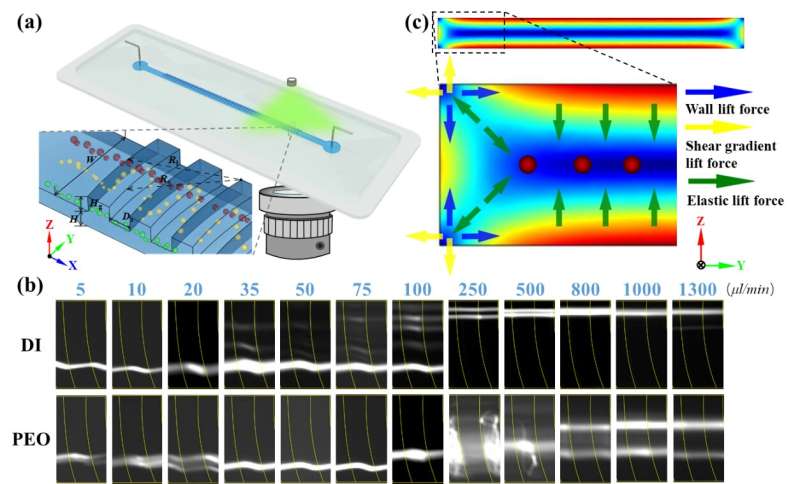This article has been reviewed according to Science X's editorial process and policies. Editors have highlighted the following attributes while ensuring the content's credibility:
fact-checked
proofread
An on-chip viscoelasticity sensor for biological fluids

A research paper by scientists at the Hebei University of Technology and Shenzhen University developed an on-chip viscoelasticity sensor for biological fluids.
The new research paper, published in Cyborg and Bionic Systems, reported a double-layered microfluidic sensor to detect the ultra-weak viscoelasticity in biological fluids.
"Most of human body fluids are non-Newtonian liquids, and the influence of viscoelasticity is often ignored for the sake of simplification of analysis. However, we found that even a very weak change in viscoelasticity can affect the trajectory of micro-particles inside the liquid. Therefore, this viscoelastic effect cannot be ignored in many situations that require elaborate analysis. For this reason, we developed this viscoelastic sensor to detect the weak viscoelastic changes of non-Newtonian liquids," explained by the corresponding author Sheng Yan, an assistant professor at the Shenzhen University.
"Our microfluidic device is [analogous] to a 'miniature liquid Galton plate'. We 'poured' a large amount of microparticles into the channel, recorded the trajectory and distribution of microparticles, and estimated the viscoelasticity of the liquid," said Dr. Yan. Experiments have proved that even for non-Newtonian liquids with weak viscoelasticity, slight changes in their viscoelasticity will cause observable changes in the trajectory and distribution of micro-particles, thus making it possible to detect subtle viscoelastic changes in non-Newtonian liquids.
To estimate the viscoelasticity of the liquid to be measured, the mapping relationship between particle distribution and liquid viscoelasticity must first be established. The process of determining this mapping relationship is called the calibration process of the viscoelastic sensor.
By observing the movement trajectory of microparticles in different viscoelastic liquids, it can be seen that "Similar to changing the nail on the Galton plate, the movement trajectory of the steel ball will be changed," said Yan, "Changing the viscoelasticity of the liquid will also change the movement trajectory of the microparticles. This shows that it is feasible to measure the viscoelasticity of liquid with this microfluidic chip."
Finally, the authors also measured the relaxation time of various non-Newtonian liquids (5-500 ppm PEO), and fitted a function to estimate the relaxation time of the liquid to be measured. According to this function, the relaxation time of the liquid to be measured can be quickly determined. For example, the relaxation times of 5 ppm and 10 ppm PEO solutions are 0.45 ms and 0.7 ms, respectively, and the viscoelasticity of plasma is closest to that of 5 ppm PEO solution, so the relaxation time is approximately 0.45 ms.
"This viscoelasticity sensor has the great potential for early diagnostics of many severe diseases," said Yan. "Via this on-chip viscoelasticity biosensor, we could detect the changes in blood viscoelasticity, which can be an important indicator for these inflammatory and vascular diseases."
More information: Qianbin Zhao et al, An On-Chip Viscoelasticity Sensor for Biological Fluids, Cyborg and Bionic Systems (2023). DOI: 10.34133/cbsystems.0006
Provided by Beijing Institute of Technology Press Co., Ltd





















